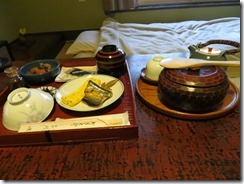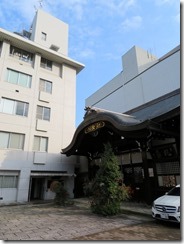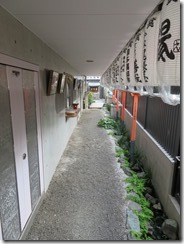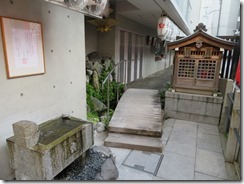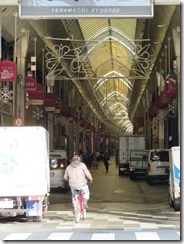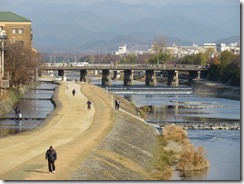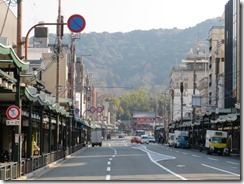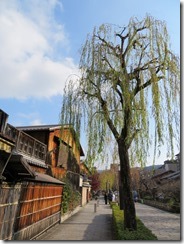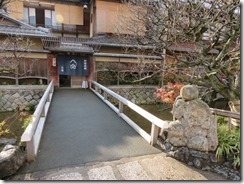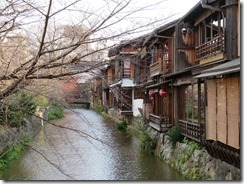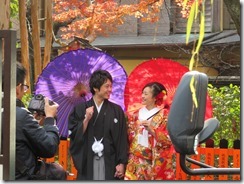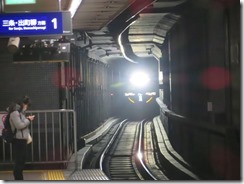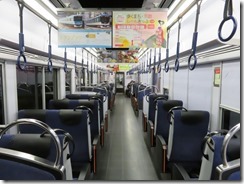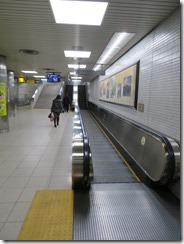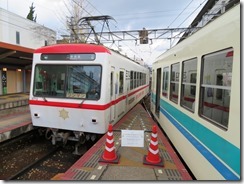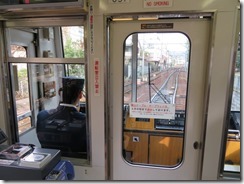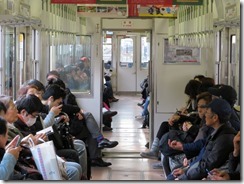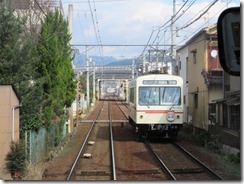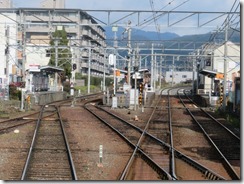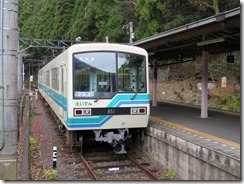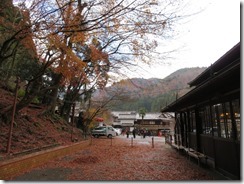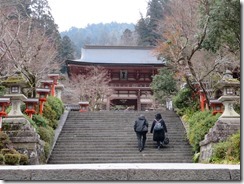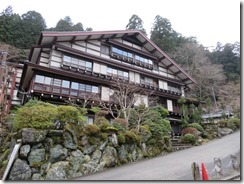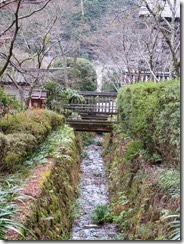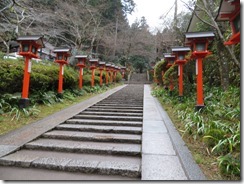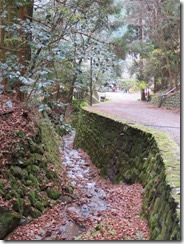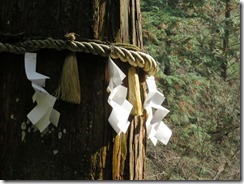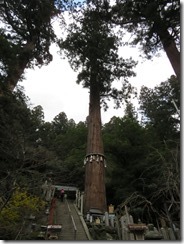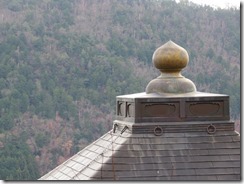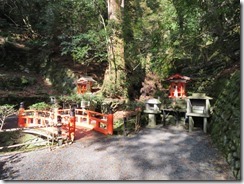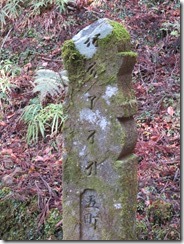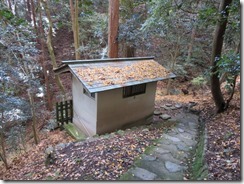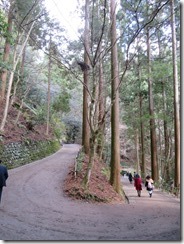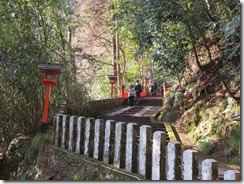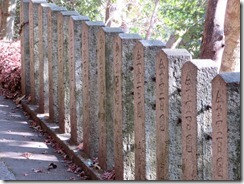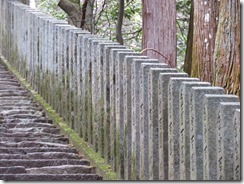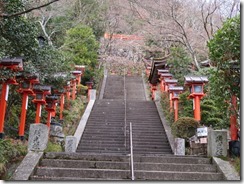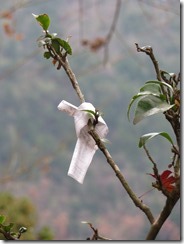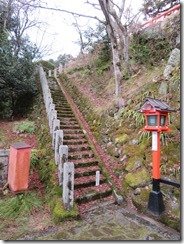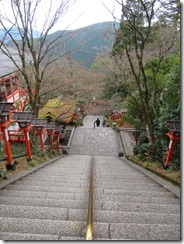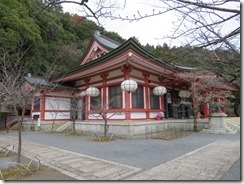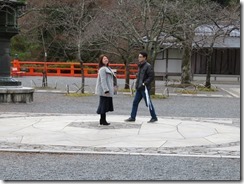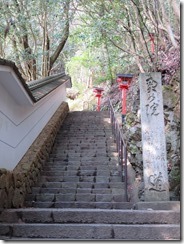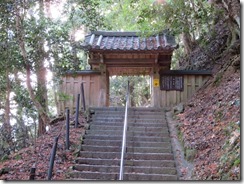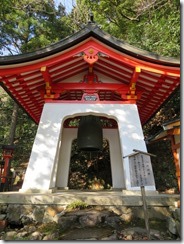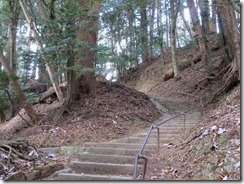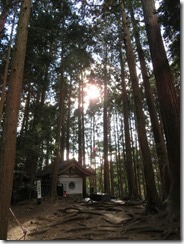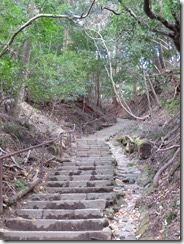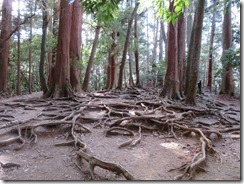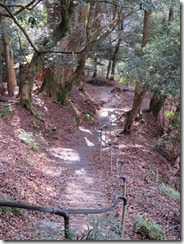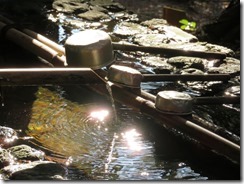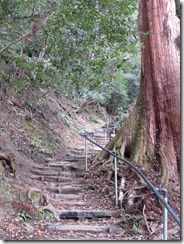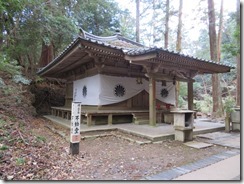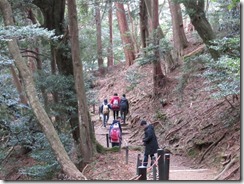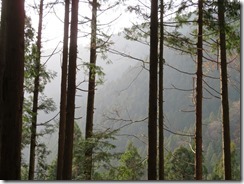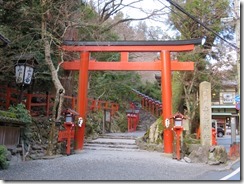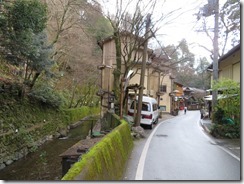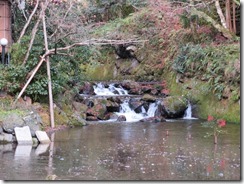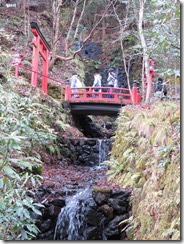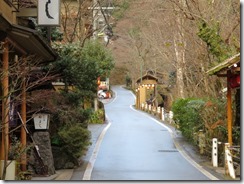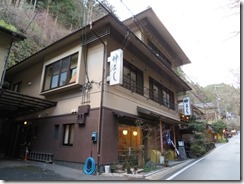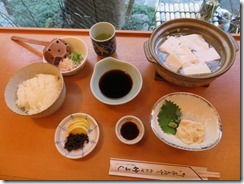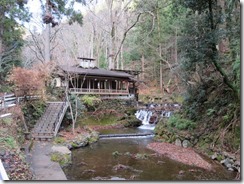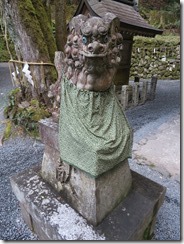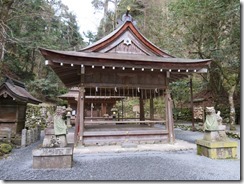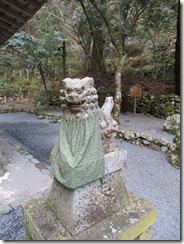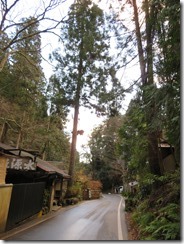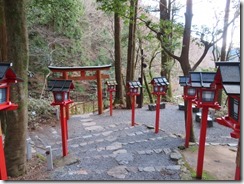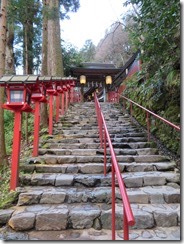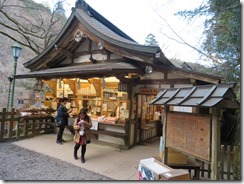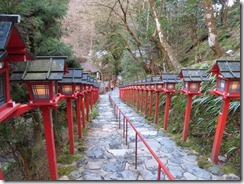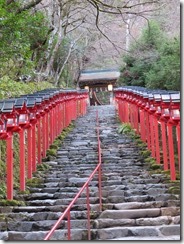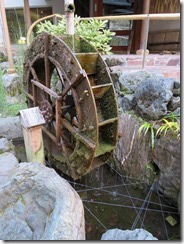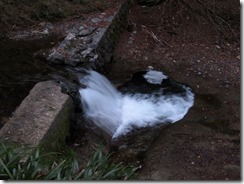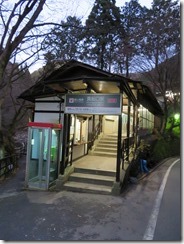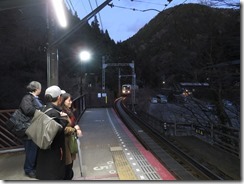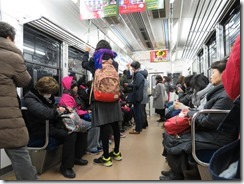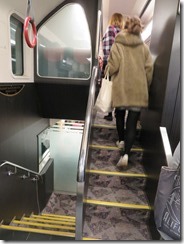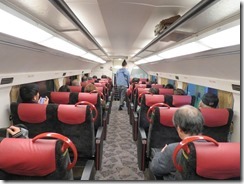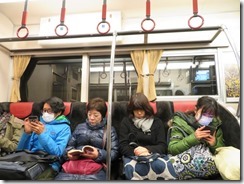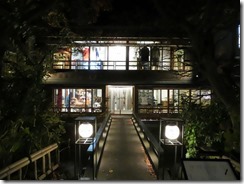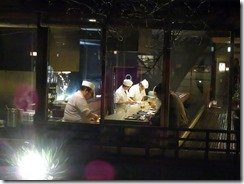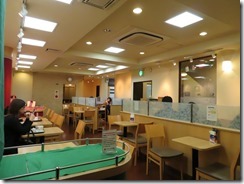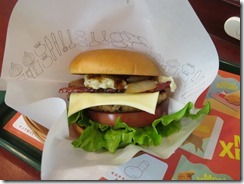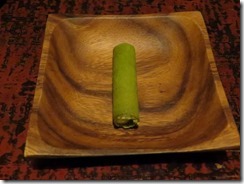Yesterday’s post now has photos.
One of the minor annoyances about planning this trip has been those little timetabling issues. I’ll have everything worked out nicely only to suddenly discover that something has a different timetable some days, requiring an excessively early start, or something is on a special timetable on this particular day. Today’s travels include one of those times – I’d intended to visit Enryaku-ji, on Mount Hiei here in Kyoto, and to that end there’s a cable car running up the mountain. Except that today is the first day that it’s closed for winter – it was open yesterday, but yesterday was already occupied by Saiho-ji…
So, once again, breakfast in the morning. While I was expecting it, fish in the morning is still a little bit… icky. Not that I’m the greatest fan of fish even at the best of times.
Headed out after breakfast to visit Gion, one of the most exclusive geisha districts in all Japan. On the way, I passed a couple of interesting shrines – Kyoto Daijingu, which didn’t seem quite so impressive as its name, and which was surrounded by office towers, and Hiyoke Tenmangu, which ran down the side of (and partially underneath) an office building.
Fun fact, though, the geisha don’t call themselves geisha, but rather geiko. Not strictly speaking a red-light district, Gion has got a whole lot of nice old buildings, and a canal named Shirakawa runs through it, which looks quite pretty. Like Pontocho, though, everything happens at night, so it was pretty quiet at the moment. Saw no less than five couples posing for wedding photos, and they were also in the middle of ripping up the asphalt on the street and replacing it with white stone pavers – apparently there’s a general beautification project going on, putting the power lines underground and so forth.
Moved on from there to the Gion-Shijo Station (hence my visit to Gion this morning), owned by Keihan, yet another of Kyoto’s private railways operators (though in actual fact, the Keihan Main Line, of which Gion-Shijo Station is a part, runs all the way to Osaka). I had a bunch of stuff I wanted to do on various Keihan lines today, and they have a day-pass ticket that covers all of those perfectly… except as I mentioned earlier, the cable car up Mount Hiei isn’t running from today, and therefore the ticket I wanted wasn’t available either. I bought the next best day-pass ticket, and headed through the gates.
The Keihan trains were really quite nice, with big comfortable seats, but sadly I wasn’t on the train for long. My first stop, Demachiyanagi Station, where I changed to the Eizan Railway’s Kurama Line. Yet another private railway company. One weird thing, though, for some reason the down escalator – and only the down escalator – at the Keihan Demachiyanagi Station has the longest lead-out section. Like, ten metres long. I couldn’t figure out why.
In actual fact the Eizan Railway Company’s lines used to belong to Keifuku, who own the Randen I rode on yesterday, but they were cast adrift in 1985 to reduce the losses the lines were taking. Today, Eizan is a wholly-owned subsidiary of Keihan. One thing I found interesting about the lines is that unlike a quite a few train lines in Japan, it was originally built double-tracked, but was reduced to single-tracked to provide steel for the war effort, before later being reduplicated.
The Kurama Line, logically enough, travels to the small town of Kurama in Kyoto’s north, and the main feature of Kurama, is Kurama-dera, my next destination for the day. After hopping off the train, I happened to spot some el cheapo plastic umbrellas for sale, so I grabbed one (I’d heard you could buy them in convenience stores too, but all the ones I’d seen so far were at least twice as expensive as the one I found here) and then headed to the temple.
Like Yama-dera, Kurama-dera is built on the side of a mountain, though not quite so severe a mountain, so it doesn’t offer quite the same views over the town below. It does offer quite a nice hike, though, right over the top of the mountain and into the town of Kibune in the next valley over. But first, I visited the temple itself.
Kurama-dera was founded in the eighth century AD, quite possibly by a monk who came from Todai-ji in Nara. From the twelfth century, it was a part of the Tendai sect of Buddhism, but in 1949 actually split away from Buddhism to form its own esoteric religion, centred on worship of Mao, who came from Venus 6.5 million years ago, though it forms a trinity with Bishamonten and Kannon, its objects of worship from its Tendai days – in actual fact, a lot of the usual accoutrements of Buddhism are still present.
It takes about half an hour to walk from the Niomon Gate to the main hall – or it does if you’re not stopping and taking photos all the time. On the way, there’s actually a Shinto shrine named Yuki Jinja. The shrine has huge cedar trees in front of it that serve in place of a tori gate, and it’s actually the site of the Kurama Fire Festival on October 22nd, one of Kyoto’s three great festivals.
Eventually I reached the main hall.
I said, eventually, I reached the main hall.
There’s actually a cable car that skips the whole climb – it’s Japan’s only officially-recognised railway line that’s operated by a religious institution, and it’s also the shortest line in the country. Sadly, it was closed today for repairs or something. Not sure I’d have taken it even if it was open, though.
At the main hall, I had a look around at things. There’s a mark on the ground in front of the hall showing where Mao first touched down (and supposedly still does from time to time). If you stand there, you can get charged with spiritual power or somesuch.
Sightseeing done, it was time to start the walk over the mountain. It was a very nice walk, though the sun was struggling to shine the whole time, and it even rained for a bit. Lots of stairs, lots of trees, and here and there were small worship halls in the middle of the forest. It was quite a nice walk, though admittedly the descent was a little bit hard on the legs. Wound up using my umbrella for all of about five minutes, when it briefly rained a bit harder than I was willing to rely on my puffy jacket to handle, then it stopped raining completely.
Eventually I arrived in Kibune. Or possibly Kifune, there’s some dispute on that subject. The town is basically one long road running up the valley along side a rushing stream – during summer, all of the restaurants along the stream put platforms across it so that you can eat over water where it’s much cooler. They don’t do that in winter, mind. The focus of Kibune is Kifune Shrine. But that came later – it was already two thirty, and though I’d had the rest of my CalorieMate on the mountain, I hadn’t had lunch yet.
It was pretty much at this point that I gave up on getting anything else done today (though it had been hovering at the back of my mind for a while), and to be honest, I’m not entirely sure why I thought in the planning stages that I could hike over the top of the mountain and still have time for something else. It did not occur to me until ten minutes after I first used my day pass ticket at the Keihan station that given my track record at keeping on time with things, buying the day-pass ticket was a stupid waste of money. The ticket cost me 1500 yen, and in total, I took rides that equated to about 420 yen in value. Not my best deal ever.
Anyway, I browsed up the main street in Kifune, but all of the places seemed to be quite expensive – some of them even costing more money than I had on me. Eventually settled on one nice-looking place offering a Yudofu Set – that’s boiled tofu, with a dipping sauce to put it in and a bunch of sides. Quite tasty.
Once done, I headed out to see Kifune Shrine. It’s actually divided into three parts, spread over about a kilometre from the first to the third. Kifune Shrine came first, and the town sprung up around it. Supposedly the goddess Tamayori-hime, mother of the first emperor of Japan, Jimmu, sailed here from Osaka in an amber-coloured boat – the shrine was built where her journey ended. Specifically, the innermost shrine, Okumiya, which I wound up seeing first. It’s got a big rock named “boat rock” which represents the boat in question.
The middle shrine is Yui-no-Yashiro, devoted to matchmaking and relationships. I was already running short on daylight, so I didn’t spend long here.
The first shrine is the main shrine, where all the people could be found, as well as the main worship hall. It’s a pretty nice looking shrine, with lanterns lining the approach stairs. You can buy a special kind of omikuji here – since the shrine enshrines the Japanese god of water, the omikuji appears blank, only to appear when you put it in water. The omikuji also includes a QR Code, which if you scan it will give you a translation… which hardly seems traditional. Actually, I saw a miko (shrine maiden) inside the shrine office using a phone and computer. I mean, I know in this day and age that probably all temples and shrines involve a computer somewhere along the line, I just found the juxtaposition a bit amusing.
However, I was running out of light, and I still had a bit to go to complete my walk – specifically, I needed to walk down the road to the mouth of the valley where I’d be able to catch the Eizan Kurama Line back to Demachiyanagi Station. It was a fairly nice walk along the river, but getting darker and darker all the time. Managed to arrive at the station just in time for the next train – though the one after, which we passed going the other way shortly after, had much nicer-looking seats.
I saw a yakiimo truck parked outside Demachiyanagi Station – kinda like an ice cream truck, except he sells roast sweet potato. Didn’t even know they still existed. I was tempted to buy something, except for the fact that I don’t really like sweet potato. The Keihan train back to Gion-Shijo station seemed to be a special one – an “Elegant Saloon” with double-decker carriages. Very nice seats. Once back in Gion-Shijo, I thought I’d see if I could get a partial refund for my ticket, but no dice – once it’s been used at all, it’s been used full stop.
Headed out for another look around Gion now that it was night time, but while there seemed to be one or two more places open, it wouldn’t really be coming to life until later. I was, however, impressed that the work crews had managed to resurface almost the entire street.
On my way back to my hotel, I finally managed to pop into Mos Burger for dinner – third time lucky. It wasn’t all that long since I’d had lunch, so I just grabbed a burger… with bacon, creamy potato, and cheese. Most tasty. Eat-in burgers are served in a basket, and the paper wrapping is kinda like a bag that’s closed only on two sides, so you can hold it more easily. Much more sense than McDonald’s burgers. This place, incidentally, had three floors of sitting space – I’ve noticed in general that while the four-floor McDonald’s I saw in Shinjuku way way back was still pretty impressive, three-floor fast-food joints… if not the norm, they’re still pretty common.
Annoyingly, I seem to have dropped my four-colour crossword-solving pen somewhere – it would have fallen out sometime when I pulled out my wallet. It’s more annoying than anything else (and I’ve got a spare), but it does raise some disturbing questions like, if it’s that easy to lose my pen, how easy is it to lose other things. Or rather, since I did lose my pen, what else might I actually have lost?
Passed a Salvation Army building on the way back to the ryokan. Little taste of home. Today’s snack seems to be a macha-flavoured Corinthian-type thing, though the flavouring wasn’t strong. Also bought a bag of Kit Kat bites from the convenienvce store for dessert – I’d heard they like releasing special Kit Kat flavours over here (largely because Kit Kat in Japanese, “Kitto Katto” sounds similar to “kitto katsu” which means “surely win), but so far I haven’t seen a single one. Had another nice bath. Now it’s time for bed.
Today’s photo count: One thousand and sixteen. Maybe what I need is someone with me to make me stop taking photos. It’s a little bit frustrating how many aren’t all that great on closer inspection, though.
Today’s step count: 16,590 steps, or 12.5km
Today’s goshuin count: Three – Yuki-jinja, Kurama-dera and Kifune-jinja.
Today’s stamp count: Not a one. Would have been nice if the Kurama Line stations had had stamps, but I couldn’t find any. I did find one in outside a shop in Gion, but it was larger than the page of my book, and it just seemed weird to use stamps in random shops.

